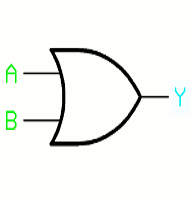
One of the most curious ambiguities that I know of is the two different meanings of the connective “or”. It’s got an “inclusive” and an “exclusive” meaning, and both of them coexist happily in everyday English. Which of the two is intended in a particular case is usually clarified from the context.
Among the reasons I find it curious is that this double meaning is replicated in various other languages, including Spanish, Italian and French. In Latin, the connective “vel” is used with an inclusive meaning, whereas “aut” has an exclusive meaning. It is strange that this useful distinction in the language that gave rise to the ones mentioned, was lost through time. The Wikipedia mentions Polish as a modern language that uses different words to distinguish these two senses.
In Formal Logic, the meaning that is usually used for the connective “or” is the inclusive one. The symbol used to denote it is the first letter of “vel”, so to say that one of the two propositions P and Q is true (or both, of course) we write “P V Q”. The exclusive version is so rarely encountered that it hasn’t got a standard symbol, and some books on Logic don’t even mention it.
An example of the “inclusive” meaning of “or” is “I wear a coat if it’s cold or raining”. Everyone understands this sentence as meaning that if it’s cold and raining, the speaker would be wearing a coat as well. Sometimes this meaning is reinforced, or disambiguated by adding extra words like “or both”, but this is not usually the case.
A typical example of “exclusive or” is when in a restaurant menu it says “with the meal you can have a drink or dessert”. Anyone trying to cling to Formal Logic will see their attempts to get both drink and dessert rebuffed. “But the menu says drink or dessert”. “Yes, and now we are clarifying, adding ‘but not both’ in it”.
Sometimes the nature of the things we are referring to is mutually exclusive. In these cases, the inclusive interpretation doesn’t make sense. “You can get there by train or by bus” never evokes an idea of a mixture between a train and a bus that could be used as transport. And the expression “dead or alive” has never involved the mythical cat which is in both states simultaneously.
In a future post we will explore this issue further, getting from this well-known linguistic ambiguity into another one that is hardly ever mentioned, using the properties of the inclusive and exclusive “or” of Formal Logic as a bridge between them.
